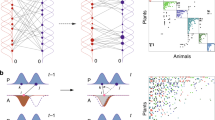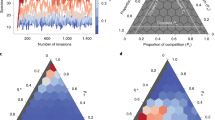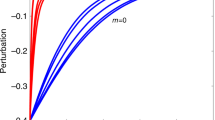Abstract
Mutualistic networks are formed when the interactions between two classes of species are mutually beneficial. They are important examples of cooperation shaped by evolution. Mutualism between animals and plants has a key role in the organization of ecological communities1,2,3. Such networks in ecology have generally evolved a nested architecture4,5 independent of species composition and latitude6,7; specialist species, with only few mutualistic links, tend to interact with a proper subset of the many mutualistic partners of any of the generalist species1. Despite sustained efforts5,8,9,10 to explain observed network structure on the basis of community-level stability or persistence, such correlative studies have reached minimal consensus11,12,13. Here we show that nested interaction networks could emerge as a consequence of an optimization principle aimed at maximizing the species abundance in mutualistic communities. Using analytical and numerical approaches, we show that because of the mutualistic interactions, an increase in abundance of a given species results in a corresponding increase in the total number of individuals in the community, and also an increase in the nestedness of the interaction matrix. Indeed, the species abundances and the nestedness of the interaction matrix are correlated by a factor that depends on the strength of the mutualistic interactions. Nestedness and the observed spontaneous emergence of generalist and specialist species occur for several dynamical implementations of the variational principle under stationary conditions. Optimized networks, although remaining stable, tend to be less resilient than their counterparts with randomly assigned interactions. In particular, we show analytically that the abundance of the rarest species is linked directly to the resilience of the community. Our work provides a unifying framework for studying the emergent structural and dynamical properties of ecological mutualistic networks2,5,10,14.
This is a preview of subscription content, access via your institution
Access options
Subscribe to this journal
Receive 51 print issues and online access
$199.00 per year
only $3.90 per issue
Buy this article
- Purchase on Springer Link
- Instant access to full article PDF
Prices may be subject to local taxes which are calculated during checkout




Similar content being viewed by others
References
Pascual, M. & Dunne, J. Ecological Networks: Linking Structure to Dynamics in Food Webs (Oxford Univ. Press, 2006)
Montoya, J. M., Pimm, S. L. & Sole, R. V. Ecological networks and their fragility. Nature 442, 259–264 (2006)
Bascompte, J. & Jordano, P. Plant–animal mutualistic networks: the architecture of biodiversity. Annu. Rev. Ecol. Evol. Syst. 38, 567–593 (2007)
Almeida-Neto, M., Guimara, P., Guimara, P. R. & Ulrich, W. A consistent metric for nestedness analysis in ecological systems: reconciling concept and measurement. Oikos 117, 1227–1239 (2008)
Bastolla, U. et al. The architecture of mutualistic networks minimizes competition and increases biodiversity. Nature 458, 1018–1020 (2009)
Bascompte, J., Jordano, P., Melian, C. J. & Olesen, J. M. The nested assembly of plant–animal mutualistic networks. Proc. Natl Acad. Sci. USA 100, 9383–9387 (2003)
Saavedra, S., Stouffer, D. B., Uzzi, B. & Bascompte, J. Strong contributors to network persistence are the most vulnerable to extinction. Nature 478, 233–235 (2011)
Krishna, A., Guimara, P. R., Jordano, P. & Bascompte, J. A neutral-niche theory of nestedness in mutualistic networks. Oikos 117, 1609–1618 (2008)
Okuyama, T. & Holland, J. N. Network structural properties mediate the stability of mutualistic communities. Ecol. Lett. 11, 208–216 (2008)
Thébault, E. & Fontaine, C. Stability of ecological communities and the architecture of mutualistic and trophic networks. Science 329, 853–856 (2010)
James, A., Pitchford, J. W. & Plank, M. J. Disentangling nestedness from models of ecological complexity. Nature 487, 227–230 (2012)
Staniczenko, P. P., Kopp, J. C. & Allesina, S. The ghost of nestedness in ecological networks. Nature Commun. 4, 1391 (2013)
Allesina, S. The more the merrier. Nature 487, 175–176 (2012)
Allesina, S. & Tang, S. Stability criteria for complex ecosystems. Nature 483, 205–208 (2012)
Campbell, C., Yang, S., Shea, K. & Albert, R. Topology of plant-pollinator networks that are vulnerable to collapse from species extinction. Phys. Rev. E 86, 021924 (2012)
Thompson, A. R., Nisbet, R. M. & Schmitt, R. J. Dynamics of mutualist populations that are demographically open. J. Anim. Ecol. 75, 1239–1251 (2006)
Holland, J. N., DeAngelis, D. L. & Bronstein, J. L. Population dynamics and mutualism: functional responses of benefits and costs. Am. Nat. 159, 231–244 (2002)
Twardochleb, L. A. N. o. v. a. k. M. & Moore, J. W. Using the functional response of a consumer to predict biotic resistance to invasive prey. Ecol. Appl. 22, 1162–1171 (2012)
Zhang, F., Hui, C. & Terblanche, J. S. An interaction switch predicts the nested architecture of mutualistic networks. Ecol. Lett. 14, 797–803 (2011)
Douglas, M. W. Adaptation and habitat selection in the eco-evolutionary process. Proc. R. Soc. B 278, 2401–2411 (2011)
McCann, K. S. The diversity–stability debate. Nature 405, 228–233 (2000)
Ives, A. R. & Carpenter, S. R. Stability and diversity of ecosystems. Science 317, 58–62 (2007)
Guimarães, P. R. et al. Interaction intimacy affects structure and coevolutionary dynamics in mutualistic networks. Curr. Biol. 17, 1797–1803 (2007)
Guimarães, J., Jordano, P. & Thompson, J. N. Evolution and coevolution in mutualistic networks. Ecol. Lett. 14, 877–885 (2011)
Nowak, M. A., Tarnita, C. E. & Wilson, E. O. The evolution of eusociality. Nature 466, 1057–1062 (2010)
Nowak, M. A. Five rules for the evolution of cooperation. Science 314, 1560–1563 (2006)
Ulrich, W., Almeida-Neto, W. & Gotelli, J. N. A consumer’s guide to nestedness analysis. Oikos 118, 3–17 (2009)
Saavedra, S., Reed-Tsochas, F. & Uzzi, B. A simple model of bipartite cooperation for ecological and organizational networks. Nature 457, 463–466 (2009)
May, R. M., Levin, S. A. & Sugihara, G. Complex systems: ecology for bankers. Nature 451, 893–895 (2008)
Proulx, S. R., Promislow, D. E. & Phillips, P. C. Network thinking in ecology and evolution. Trends Ecol. Evol. 20, 345–353 (2005)
Acknowledgements
A.M. and S.S. acknowledge the Cariparo foundation for financial support. We thank S. Allesina, T. Cooke, J. Grilli and L. Mari for discussions and Studio 7 a.m. for graphics support.
Author information
Authors and Affiliations
Contributions
S.S. carried out the numerical calculations and the data analysis. All the authors contributed to other aspects of the paper.
Corresponding authors
Ethics declarations
Competing interests
The authors declare no competing financial interests.
Supplementary information
Supplementary Information
This file contains Supplementary Methods and Discussions, Supplementary Figures 1-24 and additional references. The Supplementary Methods give the mathematical definition of nestedness and show how we have tuned the connectivity in our simulations. They also give details of the mathematical framework and optimization algorithm. All the analytical results presented in the main text are proved and the numerical simulations are explained in detail. In the Supplementary Discussions, we compare the result obtained by the Species-level Optimization, the Community-level Optimization and the Optimization while assembling the Community. Finally, we discuss the relationship between the total abundance of individuals in the community and the nestedness. See Contents for more details. (PDF 1086 kb)
Rights and permissions
About this article
Cite this article
Suweis, S., Simini, F., Banavar, J. et al. Emergence of structural and dynamical properties of ecological mutualistic networks. Nature 500, 449–452 (2013). https://doi.org/10.1038/nature12438
Received:
Accepted:
Published:
Issue Date:
DOI: https://doi.org/10.1038/nature12438
This article is cited by
-
Adaptive rewiring shapes structure and stability in a three-guild herbivore-plant-pollinator network
Communications Biology (2024)
-
Food web restoration lags behind biological communities: a case study from a floodplain wetland
Hydrobiologia (2024)
-
Inference of monopartite networks from bipartite systems with different link types
Scientific Reports (2023)
-
Disentangling the relationships among abundance, invasiveness and invasibility in trait space
npj Biodiversity (2023)
-
Estimating comparable distances to tipping points across mutualistic systems by scaled recovery rates
Nature Ecology & Evolution (2022)
Comments
By submitting a comment you agree to abide by our Terms and Community Guidelines. If you find something abusive or that does not comply with our terms or guidelines please flag it as inappropriate.



